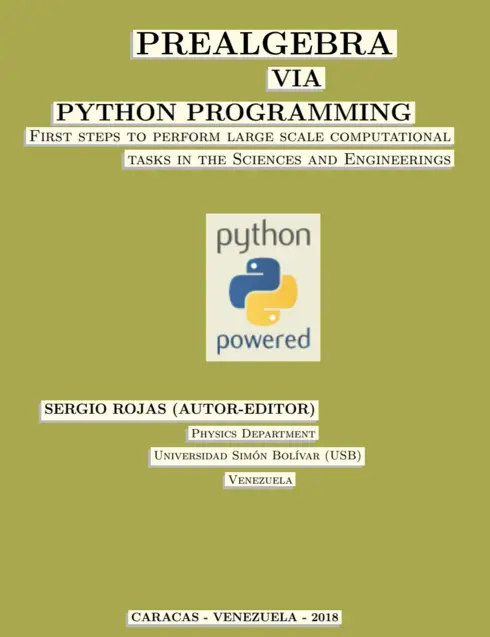
Prealgebra via Python Programming: First Steps to Perform Large Scale Computational Tasks in the Sciences and Engineerings
No ratings
Sergio Rojas, Universidad Simón Bolívar
Copyright Year:
Last Update: 2024
ISBN 13: 9789801801238
Publisher: Sergio Rojas
Language: English
Formats Available
Conditions of Use
![]() Attribution-NonCommercial
Attribution-NonCommercial
CC BY-NC
Table of Contents
- Preface
- Contents
- Getting, installing, and testing the programming python environment
- Whole numbers in Python
- Applications involving Whole Numbers via Python
- Reading and writing (input/output) in Python
- Integers and Rational numbers in Python
- Decimal numbers in Python
- Graphing and data visualization in Python
- Index
About the Book
This book was written for students and instructors who want to learn how to use a computer for other than the most common uses, such as web browsing, document creation, or paying bills online. This book is for anyone who wants to perform computational tasks that they design. In other words, if you wish to learn how to program a computer, this book is for you.
Because prealgebra is a subject that practically everyone is supposed to learn in grade school, it provides a platform to introduce basic computer programming concepts. Consequently, this book should also be of interest to students in middle or high school who want to learn how to program, and who are willing to invest the time and effort in learning a programming language that they could continue using throughout their schooling and in their professional life. Similarly, this book could also be of interest to pre-service and in-service mathematics teachers wishing to have at their disposal a complementary tool to assist in fostering understanding, competency, and interest in mathematics among their students. This book can be integrated with the teachers’ curriculum as way to tackle non-traditional math problems using an inexpensive modern computer language. By the end of the book, a reader will have learned enough to be able to write a preliminary, step-by-step one variable equation solver that can be expanded in the future to use with more complex equations. In other words, by the end of the book, you will be able to write code that programs their machines to solve equations. This code is foundational and readers are ecouraged to learn on their own how to build on it to suit their mathematics learning needs.
About the Contributors
Author
Sergio Rojas is currently a Full Professor of Physics at the Universidad Simón Bolívar, Venezuela. Regarding his formal studies, he earned in 1991 a B.S in Physics with Thesis on Numerical Relativity from the Universidad de Oriente, Estado Sucre, Venezuela, and then, in 1998, he earned a Ph.D. in Physics from the Physics Department of the City College of the City University of New York, where he worked on the applications of Fluid Dynamics in the flow of fluids in porous media, gaining and developing since then a vast experience in programming as an aid to scientific research via fortran77/90 and C/C++. In 2001, he also earned a Master’s degree in computational finance from The Oregon Graduate Institute of Science and Technology.
Sergio’s teaching activities involve lecturing undergraduate and graduated physics courses at his home university, Universidad Simón Bolívar, Venezuela, including a course on Monte Carlo Methods and other on Computational Finance. His research interests include physics education research, fluid flow in porous media, and the application of the theory of complex systems and statistical mechanics in Financial Engineering. More recently, Sergio has been involved in Machine Learning and its applications in Science and Engineering via the Python programming language.
